The Dutch Golden Age, spanning roughly the 17th century, was a period of extraordinary artistic flourishing in the Netherlands. Freed from Spanish rule and enjoying unprecedented economic prosperity, the Dutch Republic fostered a unique cultural climate where art patronage broadened beyond the church and aristocracy to include a burgeoning middle class. This demand fueled specialization among artists, and landscape painting emerged as one of the most popular and innovative genres. Within this vibrant scene, Salomon van Ruysdael stands as a pivotal figure, a prolific and influential master whose works capture the essence of the Dutch countryside and waterways with remarkable sensitivity and skill. He was instrumental in developing the distinctive 'tonal' style of landscape painting and later evolved his technique to embrace richer colours and more complex compositions, leaving behind a legacy that significantly shaped the course of Dutch art.
Early Life and Family Background
Salomon van Ruysdael was born Salomon de Goyer (or Gooyer) around 1602 in Naarden, a fortified town near Amsterdam in the province of North Holland. His family background was rooted in craftsmanship; his father, Jacob Willemsz. de Goyer, was a carpenter, likely specializing in fine woodwork, possibly including ebony frames which were highly prized. The family name change occurred early in Salomon's life. He and his brother Isaack (born c. 1599), who also became a painter and perhaps a frame maker, adopted the surname "Ruysdael." This name likely derived from Castle Ruisdael (or Ruisschedael), located near the village of Blaricum, the family's ancestral home in the Gooi region. This adoption of a place-name as a surname was not uncommon and perhaps signified a connection to or aspiration towards a certain status associated with the area.
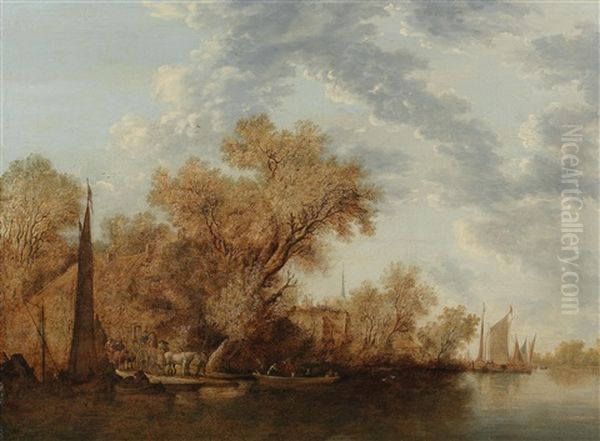
Salomon wasn't the only artist in the family. Besides his brother Isaack, his nephew, Isaack's son Jacob van Ruisdael (c. 1628/29–1682), would become arguably the most celebrated Dutch landscape painter of the Golden Age. Another family member, Jacob Salomonsz. van Ruysdael (c. 1629/30–1681), Salomon's own son, also pursued painting. This familial concentration in the arts created a dynamic environment of shared knowledge, influence, and, inevitably, occasional confusion in attributions centuries later. The family's religious affiliation is often cited as Mennonite, a Protestant denomination emphasizing peace and simplicity, which may have subtly influenced their worldview and perhaps their artistic focus on the natural world, although the religious landscape of the time was complex.
Training and Early Career in Haarlem
While details of Salomon's earliest training remain undocumented, it is highly probable that he received initial instruction within his family circle, perhaps from his elder brother Isaack. By 1623, Salomon had moved to Haarlem, a major artistic centre just west of Amsterdam. That year, he officially joined the Haarlem Guild of Saint Luke, the professional organization for painters and other craftsmen. Membership was essential for establishing an independent workshop and selling art legally. His entry into the guild marks the formal beginning of his professional career.
Haarlem in the 1620s was a crucible for landscape painting innovation. Salomon's early works show the clear influence of pioneers who were breaking away from the more colourful, detailed, and often imaginary Flemish landscape tradition. Foremost among these influences was Esaias van de Velde (c. 1587–1630), a versatile artist known for his realistic depictions of the Dutch countryside, often featuring low horizons and dominant skies. Van de Velde's relatively naturalistic approach and focus on local scenery provided a crucial foundation for the next generation.
Salomon also absorbed lessons from contemporaries like Pieter de Molijn (1595–1661) and, most significantly, Jan van Goyen (1596–1656). These artists, working alongside Salomon in Haarlem during the late 1620s and 1630s, collectively forged a new direction in landscape painting known as the 'tonal phase'. This style prioritized atmosphere and mood over precise detail and bright local colour, using a limited palette and subtle gradations of tone to evoke the hazy light and damp air of the Dutch climate.
The Tonal Phase
The period from the late 1620s through the 1630s marks Salomon van Ruysdael's engagement with the tonal style, a defining characteristic of early Dutch realism in landscape. Working concurrently with Jan van Goyen, Salomon developed a remarkably similar approach, leading to frequent comparisons and sometimes difficulty in distinguishing their unsigned works from this period. Their paintings typically featured low horizons, allowing vast, cloud-filled skies to dominate two-thirds or more of the canvas.
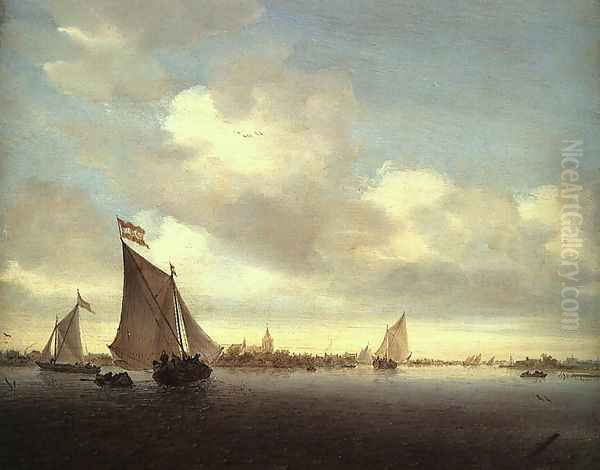
The palette was deliberately restricted, favouring muted greens, browns, greys, and ochres. This limited colour range was applied with relatively quick, visible brushstrokes, contributing to a sense of immediacy and atmospheric unity. The aim was not a photographic reproduction of a scene but rather the capture of its overall mood and the effects of light and weather. Diagonal compositional structures were common, often featuring a riverbank, road, or line of trees receding into the distance, creating a sense of depth and drawing the viewer into the landscape.
Favourite subjects during this phase included river scenes with ferries, fishermen, and small boats, quiet country roads winding past cottages and dunes, and winter landscapes. Human figures were typically small, integrated into the landscape rather than dominating it, emphasizing the vastness and power of nature relative to human activity. Works like River Landscape with Ferry (a recurring theme he painted many times) exemplify this period, showcasing the calm expanse of water under an expressive sky, rendered in subtle harmonies of grey and green-brown.
Evolution Towards Color and Light
Around the mid-1640s, a noticeable shift began to occur in Salomon van Ruysdael's work, moving away from the restrained palette of the tonal phase towards a richer and more varied use of colour. While retaining his fundamental interest in realistic depiction and atmospheric effects, his paintings from this period onward often feature brighter blues in the skies, more vibrant greens in the foliage, and stronger contrasts between light and shadow.
The reasons for this evolution are debated among art historians. It may reflect a broader trend in Dutch painting, possibly influenced by artists returning from Italy (the "Italianates" like Jan Both) who brought back a taste for warmer light and more dramatic compositions, even though Salomon himself never travelled south. It could also represent his own artistic maturation and a desire to explore different expressive possibilities. His compositions became somewhat more complex and monumental, often featuring larger, more robust trees and a greater emphasis on architectural elements like village churches or distant castles.
Despite the increased colour, Salomon never abandoned his sensitivity to light. His later works often display a masterful handling of sunlight breaking through clouds, dappling leaves, or reflecting off water surfaces. The skies remain a crucial element, filled with dynamic cloud formations that contribute significantly to the painting's mood. This later style, while more colourful, still maintained a sense of naturalism and harmony, solidifying his reputation as a master of capturing the specific character of the Dutch landscape.
Subject Matter and Signature Themes
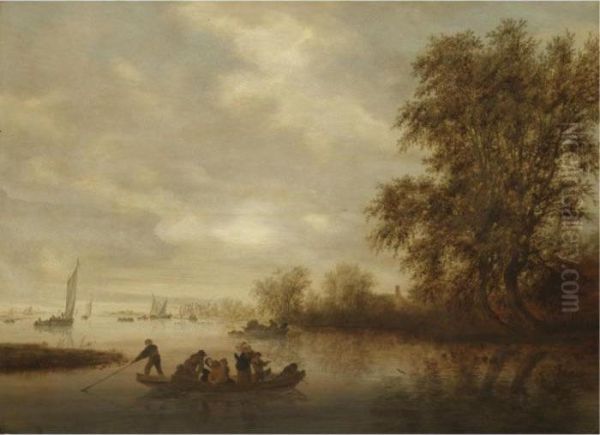
Throughout his career, Salomon van Ruysdael remained dedicated to landscape painting, exploring a range of subjects drawn from the Dutch environment. His most characteristic and frequently revisited theme is the river landscape. He depicted the wide, slow-moving rivers and canals of the Netherlands with unparalleled affection, often featuring ferry boats carrying passengers, livestock, and wagons across the water. These scenes, bustling with quiet activity, convey a sense of the everyday life connected to the waterways that were vital arteries of transport and commerce.
Village scenes, often nestled among trees or situated near water, were another common subject. He depicted the outskirts of towns like Haarlem, Alkmaar, or Dordrecht, capturing the interplay between rural life and settled communities. Marine painting also formed a part of his oeuvre, particularly from the 1640s onwards. Works like Sailing Ship off the Coast (1650s) and Marine (1650) showcase his ability to render the movement of water, the effects of wind on sails, and the dramatic beauty of coastal skies, often featuring Dutch ships navigating choppy waters.
Wooded landscapes, sometimes featuring quiet paths or ponds, also appear in his work, though perhaps less frequently than river scenes. Representative works that encapsulate his style and themes include the aforementioned River Landscape with Ferry variations, View of Sailing Boats on a Lake (c. 1650-51), which masterfully uses diagonal composition and atmospheric perspective, and numerous depictions of specific locations like the Valkhof fortress at Nijmegen or Kasteel Nederhemert, often rendered with a degree of artistic license for compositional effect. His consistent focus on these native Dutch scenes helped establish landscape as a respected independent genre.
Relationship with Jacob van Ruisdael
Salomon's relationship with his nephew, Jacob van Ruisdael, is one of the most fascinating dynamics in Dutch art history. Jacob, son of Salomon's brother Isaack, likely received his primary artistic training from his uncle Salomon and perhaps also from his father. Jacob's earliest works, dating from the mid-1640s, clearly show Salomon's influence in their subject matter (river scenes, dunes) and initial tonal approach.
However, Jacob quickly developed his own distinct and ultimately more dramatic style. While Salomon's landscapes generally convey a sense of calm, harmony, and the gentle rhythms of nature, Jacob's work often possesses a greater intensity, featuring more rugged scenery (sometimes inspired by travels to the German border region), dramatic contrasts of light and shadow, and a more profound, almost melancholic, sense of nature's power and transience. Jacob became particularly known for his waterfalls, dense forests, and imposing castle ruins, subjects less common in Salomon's oeuvre.
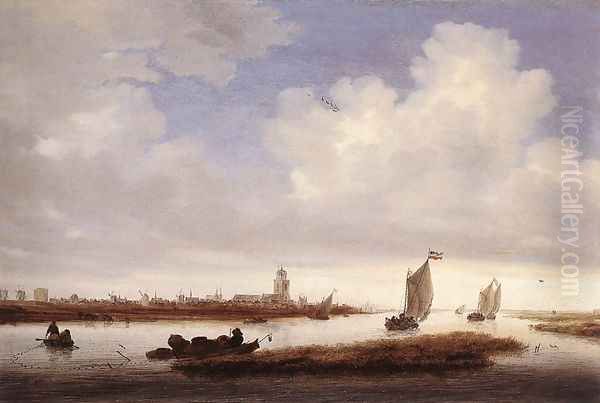
Despite their stylistic divergence, the two artists remained connected. They sometimes collaborated, or at least their works were associated, such as in a documented exhibition after Jacob's return from a trip possibly extending to the German-Dutch border area around 1650-52. The similarity of their names and, to some extent, their subject matter has historically led to confusion and misattribution of works between uncle and nephew. Generally, Salomon's touch is considered somewhat lighter and more fluid, while Jacob's is often more detailed and monumental. Salomon's enduring influence provided a crucial starting point for Jacob's own celebrated career.
Collaborations and Wider Artistic Circle
Beyond his influential relationship with his nephew Jacob, Salomon van Ruysdael interacted and sometimes collaborated with other artists in the vibrant Haarlem scene and beyond. His early development of the tonal style occurred alongside Pieter de Molijn and Jan van Goyen, representing a shared artistic direction rather than formal collaboration on single canvases.
A more direct collaboration occurred with Nicolaes Berchem (1620–1683). Berchem, primarily known for his Italianate landscapes populated with pastoral figures and animals, occasionally painted figures into landscapes by other artists, including Jacob van Ruisdael. Evidence suggests Salomon and Berchem travelled together, possibly to the eastern Netherlands or the German border region, during the early to mid-1650s. This journey likely resulted in shared inspiration and potentially collaborative works, blending Salomon's native Dutch scenery with Berchem's skilled figure painting, although documented joint canvases are rare.
Salomon worked within the rich artistic milieu of Haarlem, which hosted numerous talented painters specializing in various genres. While direct collaborations might be few, he would have known and interacted with figures like Pieter Claesz (c. 1597–1660), a master of monochrome still life; Adriaen van Ostade (1610–1685), known for his lively peasant genre scenes; and Philips Wouwerman (1619–1668), who specialized in landscapes featuring horses, battles, and hunts. This network of artists, connected through the Guild of St. Luke and the city's social fabric, fostered an environment of mutual awareness and, occasionally, stylistic exchange. His work can also be contextualized alongside other great Dutch landscapists like Aelbert Cuyp (1620-1691), known for his mastery of golden light, though Cuyp worked primarily in Dordrecht.
Beyond Painting: Other Activities
While painting was Salomon van Ruysdael's primary vocation, historical records reveal a man involved in various other activities, reflecting the often multifaceted careers of artists in the 17th century who needed diverse income streams. He was not just a painter but also an active member of the Haarlem community.

One intriguing side venture was his invention of a technique for preparing decorative ornaments, possibly for furniture or architectural elements, that imitated polished marble. This suggests skills extending into decorative arts and perhaps chemistry or material science. According to accounts, this potentially lucrative invention's secret was eventually leaked or shared, diminishing its exclusivity.
Salomon also engaged in the art market as more than just a producer. In the 1660s, he served as a member of Haarlem's art committee and acted as a 'vinder' (appraiser or inspector) for the Guild of St. Luke, roles that involved assessing the quality of artworks and possibly organizing sales or auctions. This indicates a respected position within the local art establishment. Furthermore, records show his involvement in the trade of 'blauwsel' or blue dye (likely indigo or smalt), used both by painters and in the textile industry, which was prominent in Haarlem. These diverse activities paint a picture of an artist deeply embedded in the commercial and civic life of his time, navigating the economic realities beyond the studio. Some records suggest potential financial difficulties later in life, indicated by notes regarding relatively high funeral expenses upon his death.
Artistic Legacy and Influence
Salomon van Ruysdael's contribution to Dutch art is significant and enduring. He stands as a key founder of the Dutch national school of landscape painting, moving away from earlier Mannerist conventions towards a more direct, naturalistic observation of his homeland. His pioneering work in the tonal style, alongside Jan van Goyen, established a foundational aesthetic for Dutch landscape in the first half of the 17th century, emphasizing atmosphere, light, and a harmonious, often tranquil, vision of nature.
His influence extended directly to his famous nephew, Jacob van Ruisdael, providing the initial training and stylistic basis from which Jacob launched his own influential career. He also impacted other Haarlem landscape painters and the subsequent generation. Meindert Hobbema (1638–1709), Jacob's most notable pupil, continued the tradition of detailed woodland and village scenes, building upon the foundations laid by both Salomon and Jacob.
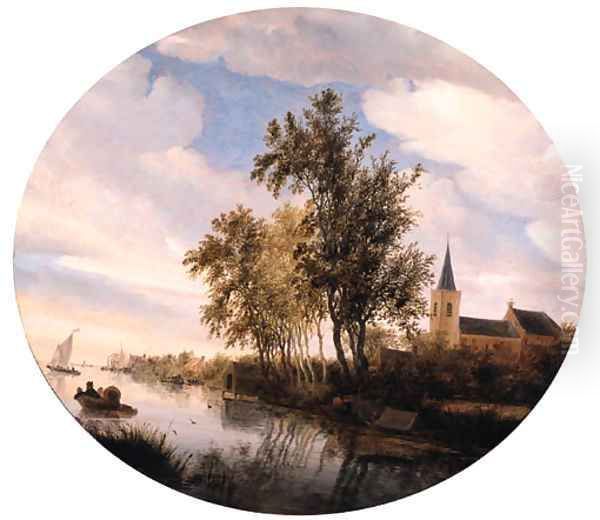
Salomon's ability to capture the specific light and atmosphere of the Dutch landscape, particularly its waterways and expansive skies, set a standard for realism combined with poetic sensibility. His works were appreciated during his lifetime and have remained sought after by collectors ever since. Today, his paintings are held in major museums worldwide and are studied as prime examples of Dutch Golden Age landscape painting, illustrating the transition from the early tonal phase to the more colourful and detailed 'classical' phase. He successfully balanced keen observation with compositional artistry, creating landscapes that feel both real and beautifully composed.
Attribution Challenges and Mysteries
Despite Salomon van Ruysdael's importance, the study of his work is not without its complexities and unresolved questions. Attribution remains a significant challenge, primarily due to the presence of other painting members within the Ruysdael family who sometimes used similar subjects and signatures. Works by his brother Isaack van Ruisdael, his son Jacob Salomonsz. van Ruysdael, and especially his nephew Jacob van Ruisdael have, at times, been confused with Salomon's. Signatures could be ambiguous ("S. Ruysdael" could potentially refer to Salomon or his son), and later alterations or forgeries further muddy the waters. For instance, works by lesser-known contemporaries like Gerrit van Hees have occasionally surfaced bearing false Ruysdael signatures.
The authenticity of certain attributed works has also been debated. Stories exist of paintings discovered in unusual circumstances, such as one reportedly found embedded in a French wall, lacking clear provenance or signature, raising questions about its true creator. The precise reasons behind his stylistic shift in the mid-1640s remain a topic of discussion among scholars – was it purely internal artistic development, or a response to external influences like the Italianate painters?
Interpreting the meaning behind certain elements in his paintings can also be elusive. His depiction of identifiable locations, like the Plompetoren tower in Utrecht or Kasteel Nederhemert, sometimes takes liberties with topography for artistic effect, blending observation with idealization. While generally secular, occasional works incorporate subtle religious themes (like depictions related to the Road to Emmaus), the specific intent or reception of which can be hard to ascertain fully today. These ambiguities highlight the ongoing research and connoisseurship required to fully understand his oeuvre.
Final Years and Enduring Reputation
Salomon van Ruysdael remained active as a painter in Haarlem throughout his life. He continued to produce landscapes, adapting his style but remaining true to his core interest in the Dutch scenery. He was a respected figure in the Haarlem community, involved in the Guild of St. Luke and civic affairs.
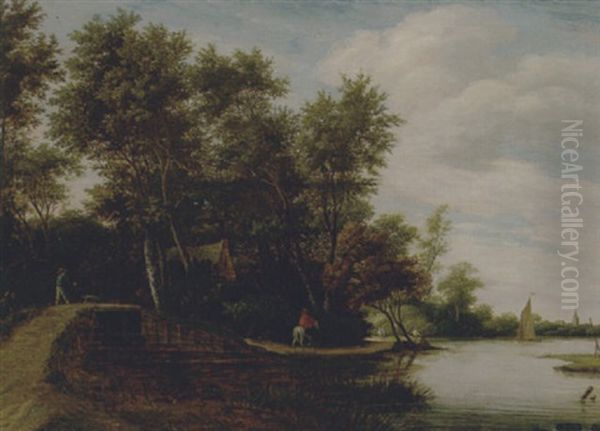
He passed away in Haarlem and was buried in the Sint-Bavokerk (St. Bavo's Church) on November 3, 1670. This magnificent church, a landmark of Haarlem, also became the final resting place for his nephew Jacob twelve years later, uniting them in death as they had been linked in art during their lives.
Salomon van Ruysdael's reputation rests securely on his mastery of landscape painting. He was a prolific artist whose works capture the tranquil beauty and specific atmospheric conditions of the Netherlands with exceptional skill. As a pioneer of the tonal style and a master of depicting water and sky, he played a crucial role in establishing landscape as a major genre in Dutch art. His paintings offer a window into the 17th-century Dutch world, celebrating the quiet harmony between humanity and the natural environment.
Conclusion
Salomon van Ruysdael occupies a vital position in the history of art. Emerging during the formative years of the Dutch Golden Age, he helped define the very essence of Dutch landscape painting. From his early, atmospheric tonal works created alongside contemporaries like Jan van Goyen, to his later, more colourful and detailed canvases, he consistently demonstrated a profound sensitivity to the nuances of light, water, and sky. His depictions of river ferries, village outskirts, and wooded scenes are not merely topographical records; they are poetic interpretations of his native land. As the uncle and likely first teacher of the great Jacob van Ruisdael, and an influence on figures like Meindert Hobbema, his impact extended through generations. Despite challenges in attribution and interpretation, Salomon van Ruysdael's legacy endures: he remains celebrated as a foundational master whose art beautifully encapsulates the spirit and scenery of the Dutch Republic in its golden century.